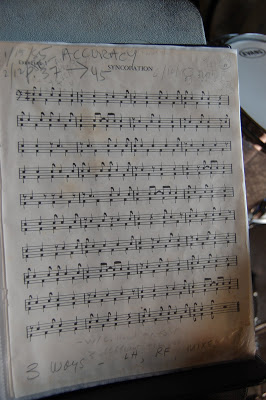
Start with a book like Ted Reed's Progressive Steps to Syncopation for the Modern Drummer or something similar.
#Ted reed syncopation exercises how to#
Here's how to develop this powerful technique. And with practice, it will become second nature.

Once you study the exercises that follow, you'll understand exactly how Buddy accomplished this exciting interaction.

This powerful "fill-in" technique not only gives you a multitude of Drum solo possibilities, it allows you to "fill-in" behind other soloists in the band, adding another level of excitement to your music. Sound complicated? It's really not, once you understand how it works. Where most drummers threw in a cut or two occasionally, Buddy would constantly interact with the soloist and other band members. This is something that Buddy did extremely well.
#Ted reed syncopation exercises pro#
You are very useful and I’m starting to like you.In part one I showed you how to develop Kick Drum Substitutions, one of Buddy Rich's favorite solo and fill-in techniques (see Part 1 of Pro Secrets: Buddy's Bag in the Related Links sidebar.) This time, more secrets from Buddy's bag of tricks.Īnother favorite technique of Buddy's was to take an existing rhythmic line and play it with his left stick on the Snare and then fill-in the remainder of the rests with eighth-note triplets played on the Kick Drum or vice versa. I can’t conclude this post without sending my apologies to the rock beat for my earlier slight. I’ve started working through a few songs and will see what I can do with them. It may be a little too soon to try, but I’m sure the trying will be fun and I’m looking forward to it. In other news, an opportunity has come up and I might get a chance to try playing music with others in the near future, but I won’t write too much about that until it has actually happened. So, that’s one of the things I’m working on now. By the time I try it at the kit it doesn’t take long for me to play it evenly and at a good speed. I find it difficult to do, but it’s getting easier and really does work. But once I’ve played them through a number of times I get a good feel for the rhythm.Īs I mentioned at the end of my last post, I’ve been approaching this in a new way, looking at the music first and visualizing the beat to train myself to “hear” it before I play. For example, the ones where there isn’t a beat on ‘1’ (which I didn’t write out, but I’m sure you can picture it) are hard to get into since it’s my habit to play the bass on ‘1’. It’s neat how small changes to the bass pattern can make big change the sound and feeling of the entire groove. When I play them like this the sound is similar to the hiphop grooves I’ve been working on. Line 5 of p.33, as written in the book, and how it fits together with the rock beat. I’m sure I will be revisiting that section in the future to try it out in a different way. It was a good refresher and practice for sight reading. I’ve got some experience reading music, although a little rusty, so going through the first section in that way went quickly. I played through the first section in a simple way, playing the lower line on bass and the top one on snare, over the course of a week. It uses the 5 line staff, but instead of each line/space being a note, it represents a physical piece of the drum kit – bass, snare, hi hat, toms, etc. Sheet music for drum is different than for other instruments. The first section of the book is note-reading and rhythm exercises. I’ve titled this post as ‘Part 1’ because I’m positive that I’m going to be working with it off and on for a long time. People play with different limbs, change accent placement, add swing, and probably even turn the book upside down. Drummers use the exercises in many creative ways, applying the rhythms to practicing coordination and creating new sounds. The intention was to teach snare drum players how to read music, but it is used for much more than that. This book is a collection of exercises that Ted Reed wrote for his students and published in the late 1950’s.

Here’s an example, using line 1 on page 33 of the book. I’m currently practicing playing a syncopated rhythm on the bass drum, accompanied by the hihat and snare parts of the basic rock beat.


 0 kommentar(er)
0 kommentar(er)
